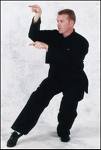|
Southern Praying
Mantis (南派螳螂) native to the Hakka (客家) communities of Southern China.
Despite having the name “Praying mantis”, this style is completely unrelated
to the Northern Praying Mantis style. In terms of history and techniques,
the Southern Praying Mantis is more closely associated with fellow Hakka
styles such as the Dragon (龍形拳) or Bak Mei (白眉拳) and more distantly to the
Fujian family of styles that includes Fujian White Crane (白鶴拳), Five
Ancestors (五祖拳), and Wing Chun (詠春). There are four main branches of
Southern Praying Mantis being practised worldwide. |
 |
|
Southern Praying Mantis is a
close range fighting system that places much emphasis on short power and has
aspects of both internal and external techniques. In application, the
emphasis is on hand and arm techniques and limited use of low kicks.
Like other Southern Chinese
martial arts, Southern Praying Mantis is characterized by a strong stance,
powerful waist and fast, heavy forearms and quick hand movements. The
essences of the style is captured in various poetry and mnemonic aids.
Training includes a variety of solo forms, pair practise, and weapon
practise. The name and type of form will vary between branches. In the
Australian version of Chow Gar Tong Long under the direction of Henry Sue,
the form structures are as follows:
Sarm Bo Gin
Sarm Bo Yil Sou
Sarm kung Bic Kuiel
Sarm Bo Pai Tarn
Tong Long Bow Sim Sou
Tong Long Won Sou
Sarm Bo Gin is considered one of the most important forms of the southern
mantis system. It is a hard chi gung form and is usually the first to be
learned. It strengthens the body, aiding its resistance to physical blows,
and also develops power. The form should be done everyday, preferably early
morning. |













